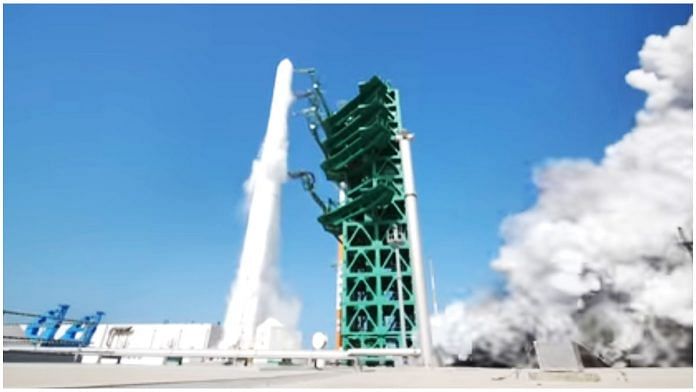Bengaluru: South Korea successfully launched its first fully domestically-built rocket Tuesday, deploying a small satellite. The three-stage Nuri rocket lifted off from the Naro Space Center at 4 pm local time (0700 GMT), placing a working satellite, as well as a dummy satellite, in a 700-km-high orbit.
This makes South Korea the 11th country capable of sending a satellite into space with its own technology; it had previously launched a rocket in 2013, but that was built with Russian aid.
Tuesday’s launch was the second attempt to launch the Nuri rocket (nuri means “world” in Korean) after a failed test last October when the rocket’s third stage stopped burning 46 seconds earlier than it was supposed to. As a result, the dummy payload reached the required altitude but was not inserted into orbit.
Staging is a process by which most launchers discard a portion or part of the vehicle in order to lighten the weight of the vehicle to achieve orbital velocity.
“Dear fellow citizens, the space of [the] Republic of Korea is fully open. The science and technology of [the] Republic of Korea has made a great advance,” South Korean Science Minister Lee Jong-Ho said at a press conference after the launch. “The government will continue its audacious march toward [becoming] a space power with the people.”
This makes South Korea the 11th country — excluding collaborative efforts by the former Soviet Union and the European Space Agency — to be fully launch-capable. South Korea joins the Asian states of India, China, Japan, and North Korea, Israel and Iran, who have their own domestically built and orbital launch capable-rockets.
Elsewhere, Russia, France, the UK, and USA also have their own rockets. France and the UK also fly with the European Space Agency’s (ESA)’s launchers. Ukraine, too, has its own modified rocket inherited from the Soviet era.
After being placed in orbit, the working satellite, which established verification of orbit insertion (that is, it was inserted into orbit correctly), confirmed its status to a South Korean station in Antarctica.
The working satellite contained four CubeSats — square-shaped miniature satellites each roughly the size of a Rubik’s cube — which will be released in the next few days for earth observation.
The launch was telecast and publicised widely in South Korea, and four more launches are expected to follow soon. The country is also working on a lunar orbiter named the Korean Pathfinder Lunar Orbiter (KPLO).
South Korea has sent about 25 satellites launched by European and American carriers to space since the early 90s, and in 2013, launched the Naro-1 rocket built in collaboration with Russia from its own soil.
(Edited by Uttara Ramaswamy)
Also Read: ‘Where’s the research?’ Why space institute IIST’s tailor-made graduates don’t stay at ISRO



